Offa's Dyke - Days 3, 4 and 5:
Our meal at the end of day 2 was lots of fun. As we walked into the pub we met again the lady who had found Mary's phone on day 1, struck up a conversation, and she joined us for a sociable evening of chatter over rustic grub. It turned out Caroline was a teacher and so we had a fine old time going over teacher talk. We shared classroom based triumphs and tragedies and the usual moans and gripes about the state of the education "system" that all teachers appear to share.
The next morning, as expected, it was raining and the country was covered in low rolling mist. Nevertheless we set off in good spirits and determined to climb up onto the ridge for the views.
Little did we know how different our situation would be by the end of the day.
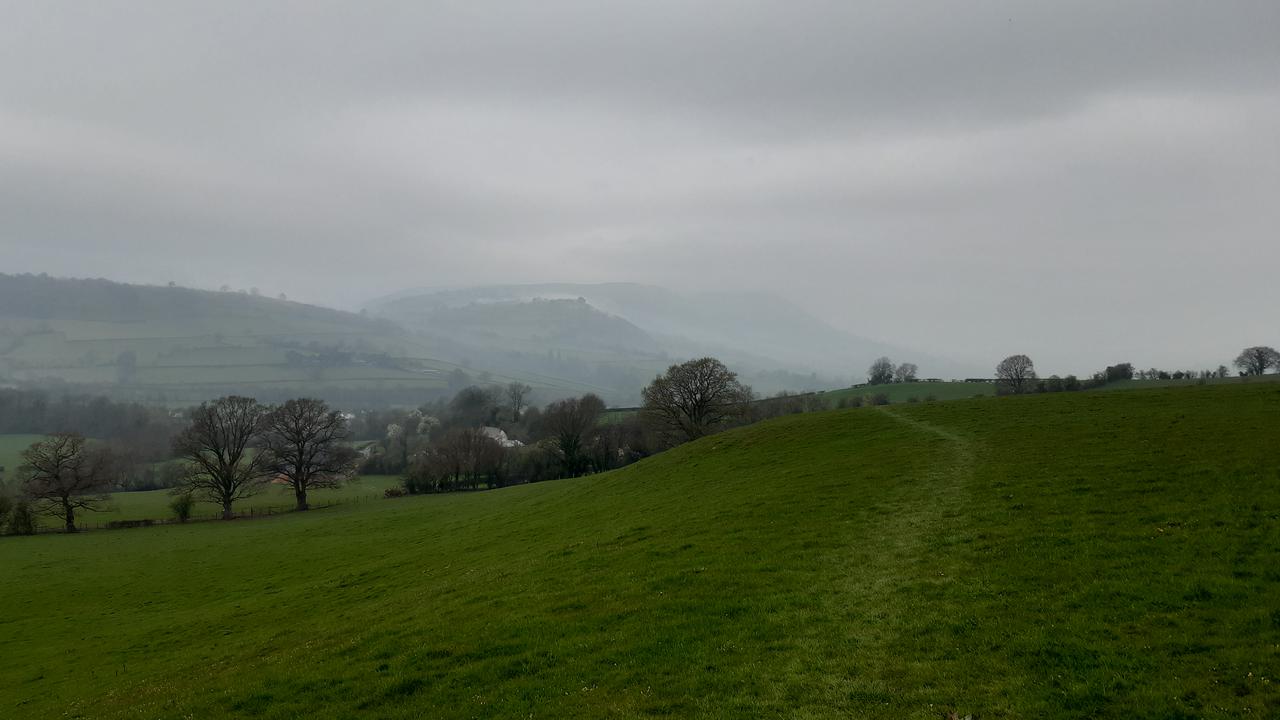
After a couple of relatively swift miles tramping the rolling countryside to Pandy, we started to ascend the edge of the Black Mountains. Since we were laden with all our clobber this took a while: but our mantra was "slow and steady does it". We could have stomped up, like I usually do, but we decided to save ourselves for the 15 miles of walking over the ridge we would need to complete to get us to Hay-on-Wye by the end of the day.
The first sight to greet us upon completing our ascent was an ancient hill fort from pre-Roman times. Even after 2500-3000 years, the dykes and ditches that marked the boundaries of the fort were an imposing site, especially as they loomed ominously out of the mist.
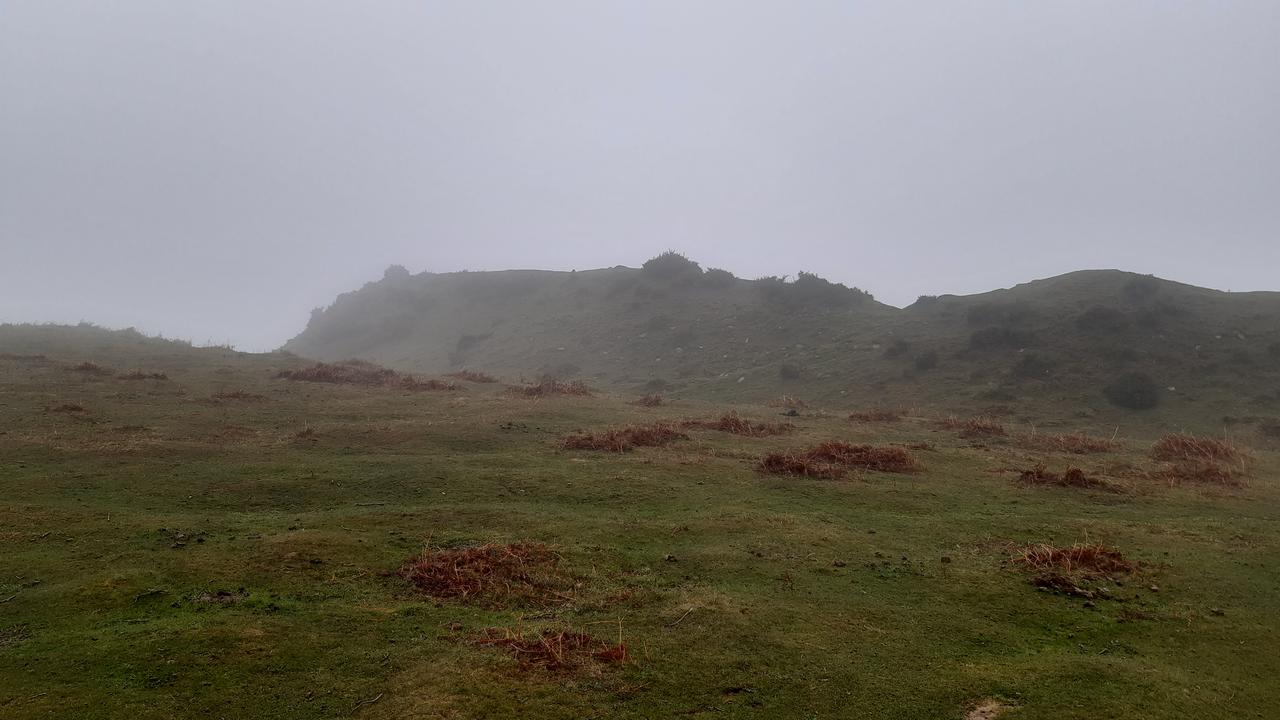
And so, it was at this point, we resigned ourselves to the fact that the weather would be against us for the day. There would be no beautiful views over mountains or down into valleys for us. In fact, we could only see about 20 metres ahead of ourselves. Fortunately the path for the Offa's Dyke trail was obvious, so we just had to trudge on (and on, and on).
It's hard to remain motivated when all around you is freezing fog. There's no sense of progress and it's impossible to look back to see how far you've come, or look ahead to a marker in the distance as a target to aim for. Yet sometimes we would pass way-points that marked the tops of peaks, and this photo, taken perhaps just before lunchtime, is a good indication of our conditions.
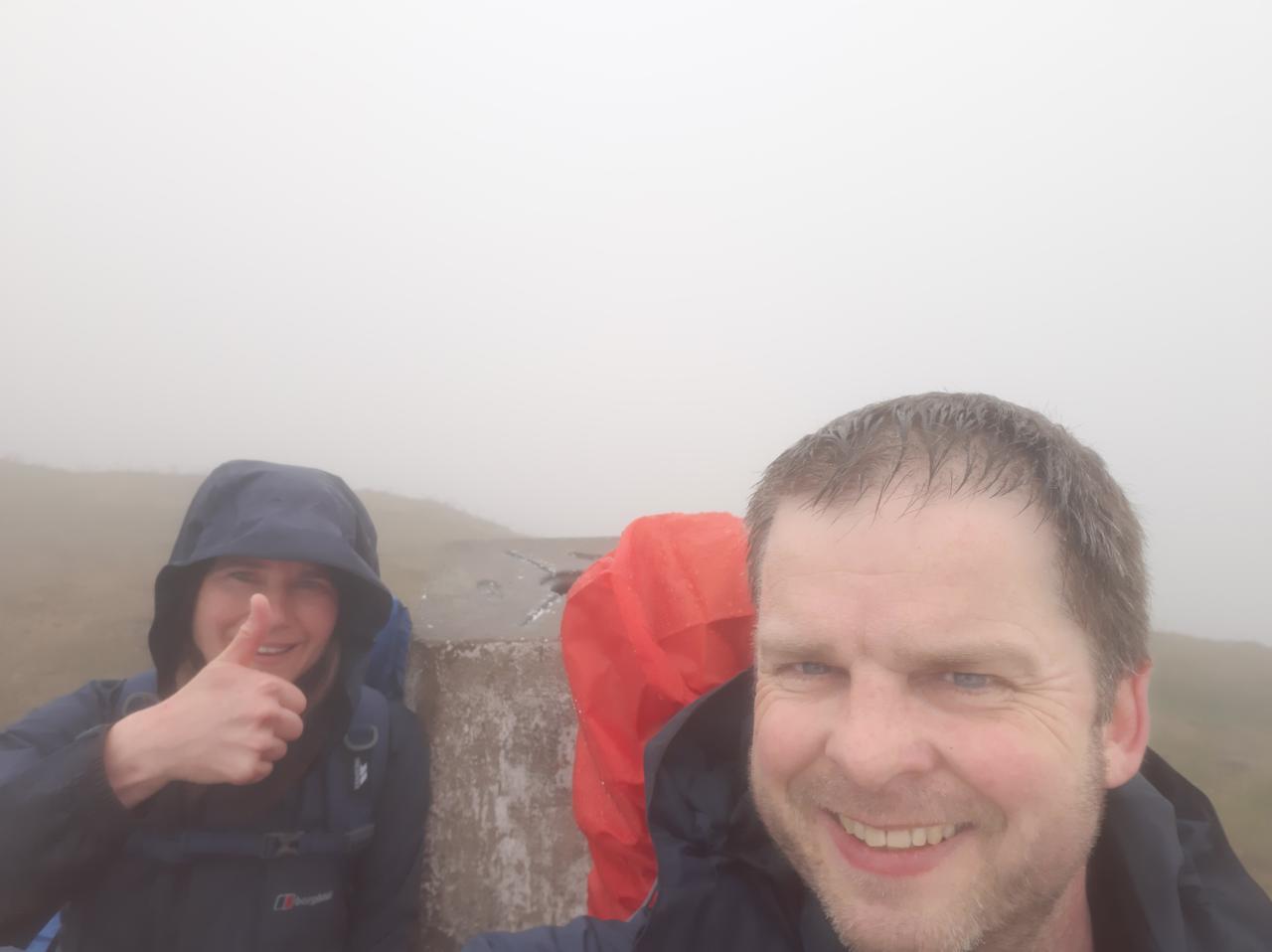
We also felt quite alone: by lunch we hadn't met a soul. Yet we were not the only ones tramping the hills that day. Huge piles of steaming dung alerted us to the presence of others, just out of sight.
And then suddenly, we came upon the group of wild horses grazing the grass. They took a look at us, pondered for a few seconds why on earth two humans would be up there with them, and then returned to the more pressing task of grazing again.
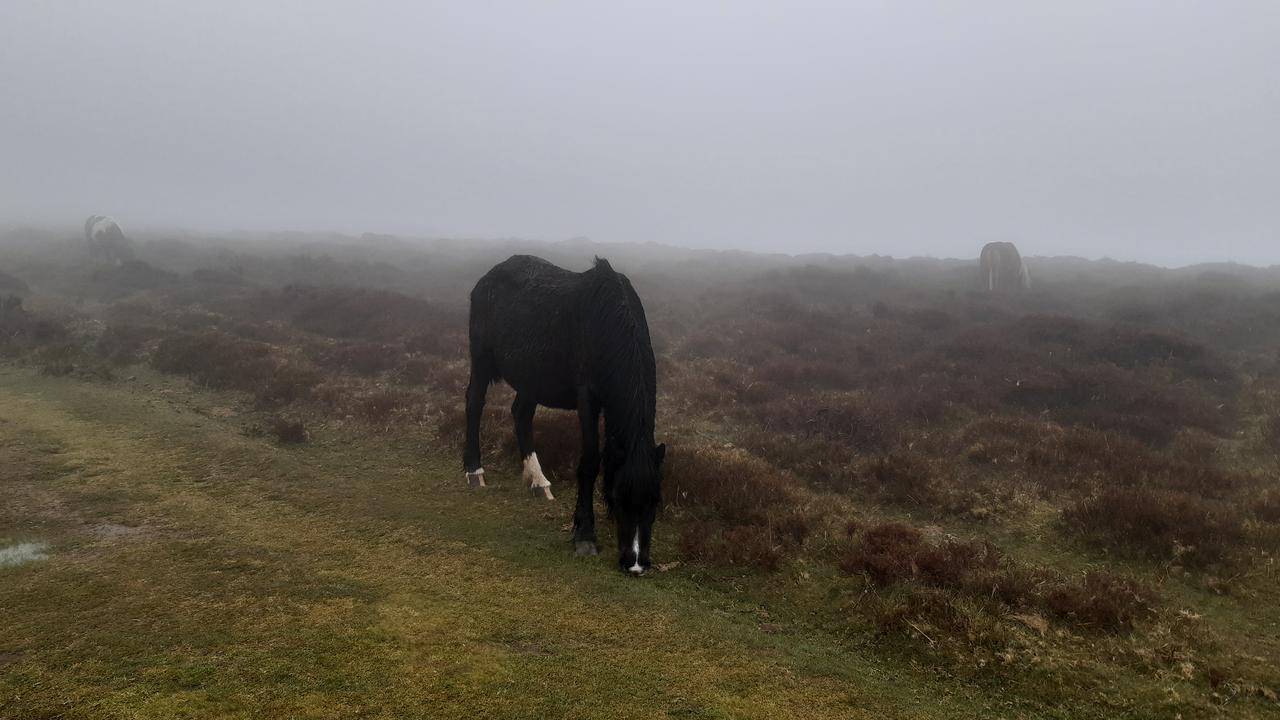
At some point mid-afternoon the conditions under-foot became much more boggy and the path turned into a set of paving slabs. We joked that Offa must have sourced them from the local garden centre...
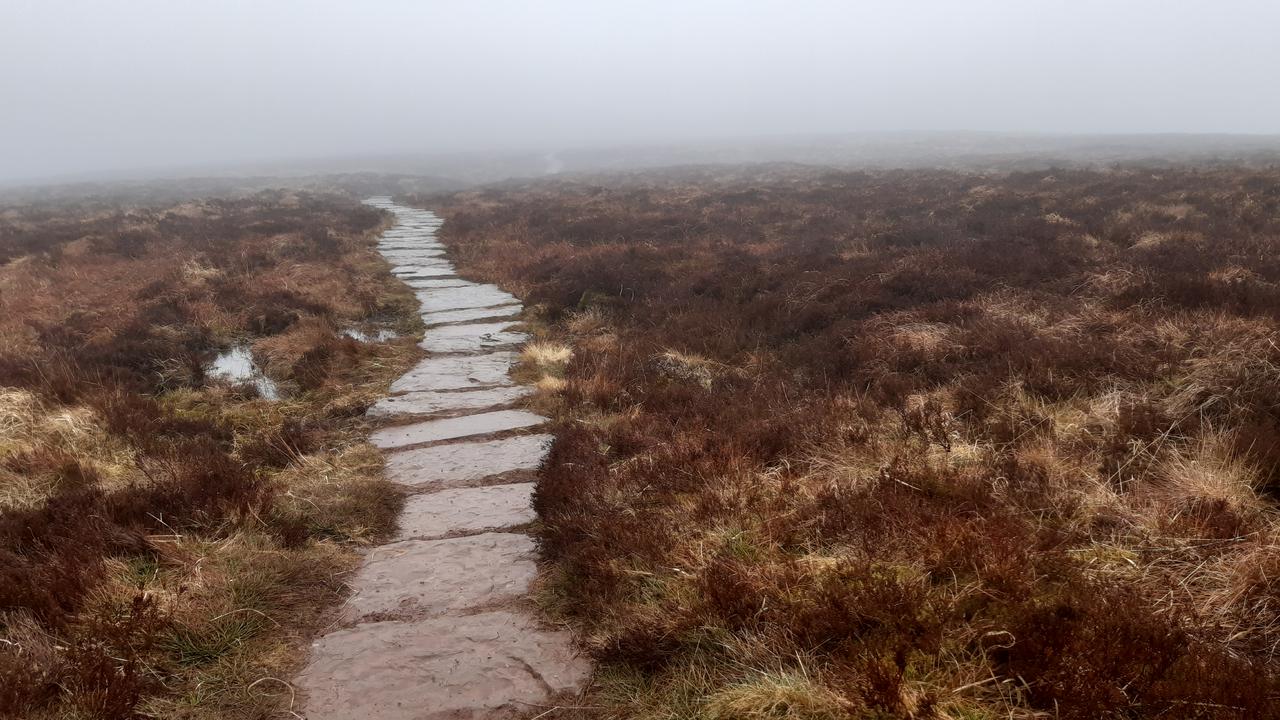
...but we were thankful that they helped us avoid tramping through the black peaty mud. Perhaps this is how the mountains got their "black" name?
We also started to realise that not all was well for either of us.
My feet and ankles ached and while Mary found it comfortable to walk up hills, and over the levels, descending was very painful because of her right knee. This got gradually worse throughout the day, to the point that it couldn't be ignored, and we started to talk about what we might do about the situation.
As you can see from this photo, we were determined to put a brave face on things but I think we both realised things were not going as they should (we're no longer spring chickens!).
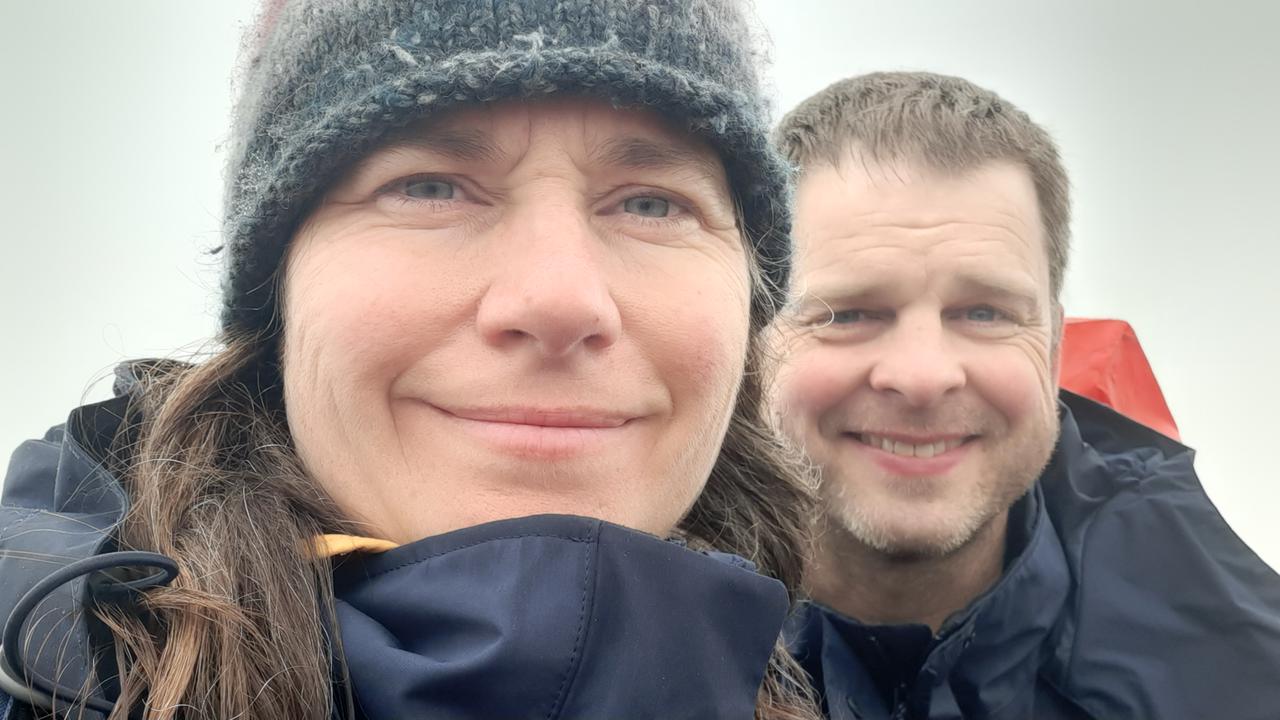
Then, around mid-afternoon we met the first people of the day. Two fellow walkers appeared out of the mist towards us, and we shared some encouraging words. Yet just as we were commenting how deserted the ridge was, a young man came from the same direction as us at a fast pace. He stopped to say a quick "hello" only to realise his small back-pack had come undone. He checked his things (nothing missing), re-adjusted his equipment and stomped off in the direction of Hay -- a momentary mist-clad apparition accelerating into fog. We parted company with the other couple and wished them well, only to encounter a group of Duke of Edinburgh participants (in the UK we have something called the "Duke of Edinburgh Award" for teenagers, that encourages them to explore and encounter nature and outward bound activities). We helped them with some map reading and then, gazelle like, off they sprang into the mist leaving us to ponder our ever slowing pace and the fact that, like London buses, we had met nobody all day only for three different parties to turn up within minutes of each other.
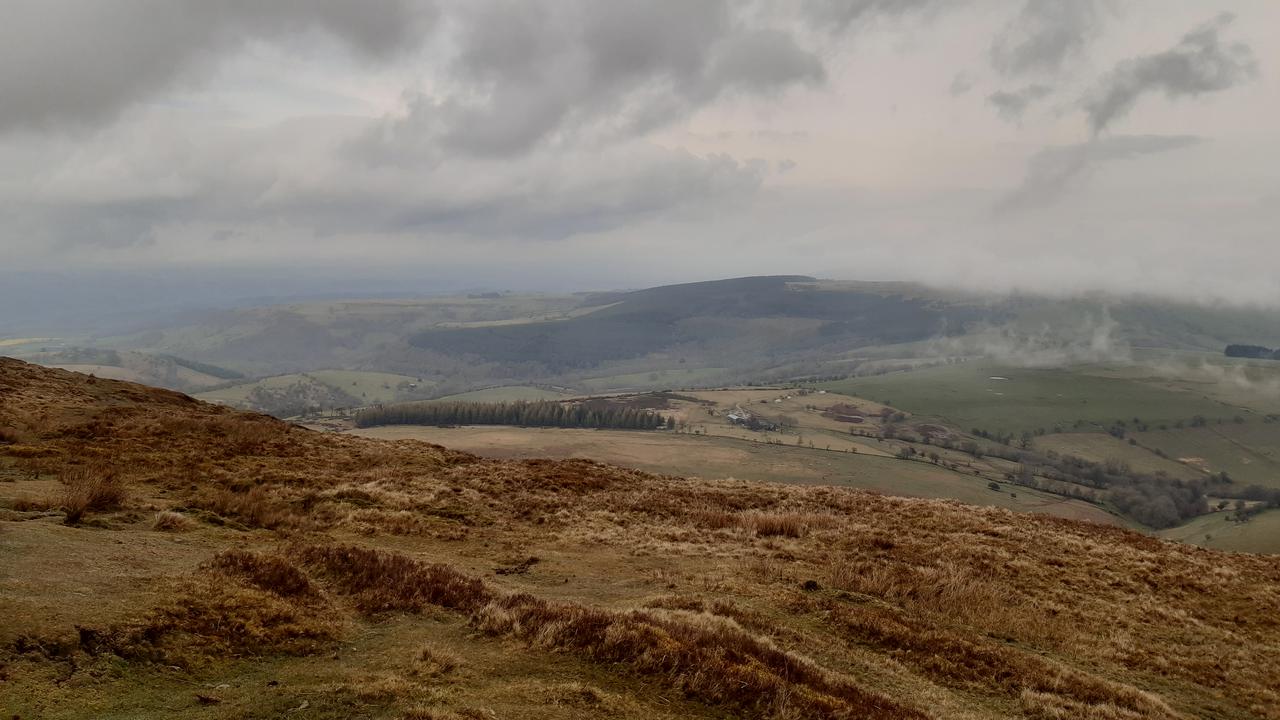
As we got to the end of the ridge, the mist lifted and we were able to finally see some views. Yet these were not to last since we had to make our descent, and it was here that things got very tricky.
My poor Mary had to endure intolerable pain in her knee as we made our way down the side of the mountain towards Hay-on-Wye. The first of several steep descents should have only taken us perhaps 20 minutes but, in fact, took an hour. We had several more descents to go until we reached our destination.
Yet we spied a line of cars parked in the distance, and this proved to be our way out of the difficult and painful situation.
It was clear the final couple of miles to Hay were all down hill with difficult conditions under foot. My feet were a constant source of a dull ache, and if I stopped walking the pain would become strong and resuming the walk took lots of effort. Mary was clearly in a lot of pain with her knee, and so our journey was no longer the happy, if tiring, adventure we had enjoyed up until this point.
As we approached the parked cars I tried a few local taxi companies, but nobody picked up.
Thinking we may need to just press on, I spotted one of the cars was occupied. I tapped on the window to find a man of a similar age to ourselves inside. He told me he was there just to enjoy the view and to get out of the house for a while. I explained our situation and he very kindly offered to drop us off in Hay.
What a relief.
Except, he suddenly remembered, "by the way, I have COVID".
He had driven to the beauty spot just to get out of the house since he had been isolating for the past few days.
We had a quick (socially distanced) chat about the potential logistics of the situation and worked out a way for us to get a lift, but with him masked up with the addition of a scarf around the lower part of his face, and us sitting away from him with all the windows of the car open.
I have to admit, we made the right decision because our speed due to the knee situation was at a snail's pace and it would have taken several hours to cover the final two miles into town.
In the end, we had a fun chat with Carl (our impromptu driver) and I think he enjoyed the sense of adventure the situation presented. We were deposited right outside our guest house in Hay, got to our room and collapsed into the shower.
After a couple of hours of rest we had stiffened up.
I examined my feet and found they were covered in blisters and Mary's knee was, to use her words, "shot to pieces".
It was clear that our journey to walk Offa's Dyke was coming to an end and we both felt sad and deeply frustrated by the situation. As Mary put it, "I feel fine from the right knee up", and I was also in fine fettle from the ankles up.
Yet we could not continue given our different ailments.
And so, we decided to change plan.
Over dinner in the Blue Boar Inn (excellent food and beer), we worked out what to do next. We'd booked places to stay along our route, and we certainly didn't want to abandon our holiday, yet we clearly couldn't walk to the extent that we would need to, and it was clear our current situation required us to rest and recover before attempting any further distance by foot.
In the end we decided to transform our holiday from a "by foot" affair to a touring holiday with a car on hand, which leads us to day 4's adventures.
We booked a taxi to pick us up at 9am the next morning and take us to Hereford station. From there we took a train to Shrewsbury and another short taxi hop to the village where Mary grew up, her parent's house, and the place where we'd parked our car.
The journey was uneventful, the highlight being the local taxi driver from Hay-on-Wye.
Within seconds of picking us up he had asked us about our reason for being in the place and Mary reciprocated by asking what living in such a beautiful place as Hay-on-Wye was like.
"Well", he ruefully started, "there's us, and then there's them."
Knowing he had a captive audience for at least the next 45 minutes, he went on to explain that Hay-on-Wye has a highly stratified population. By "us" he meant those born and bred in the place scraping a living via a few relatively menial jobs. By "them" he meant, "city folk who sell up, move here and lord it all over the place like they're millionaires". This included the owners of various "lifestyle" shops, coffee houses in the town, and artisanal crafty places.
We hadn't seen that much of Hay-on-Wye so didn't have any evidence to check his appraisal of the situation. We were sympathetic to his cause and he was clearly enjoying putting the world to rights. As he dropped us off he even commented that he'd had a jolly old time getting things off his chest. Clearly, we were good (captive) listeners.
Once we picked up our car, we made our way back into Wales and our place of rest for the next night: Kington. During the journey we realised we were passing close by the village where Mary's widowed aunt (who we hadn't seen since before the pandemic) had settled with her new partner. We called ahead and made arrangements to drop our stuff off in Kington before joining our relative for a lovely meal and evening of catching up. It was lovely to see she was so settled and happy with her new partner.
This morning, after a good night's sleep and a lovely relaxed breakfast we decided to drive back to Hay-on-Wye and look around... with both of us being avid readers, the thought of all the book shops, for which Hay is so famous, was a real draw.
Yet, within minutes of our arrival we could see yesterday's taxi driver was onto something.
Hay-on-Wye was clearly a beautiful place, but had transmogrified into a sort of unintentional parody of itself. We found shops full of pointless crap, new age treatment centres that gave the place a smell of cheap incense, and a faux farmer's market full of "artisans" selling yet more nick-nak crap (there wasn't an actual farmer in sight).
Mary's knee was also playing up again.
Despite our very gentle pace we ended up in the chemist's shop to buy a knee support to try to help with the pain. After following directions to the local public toilets (so Mary could put on the strap under her trousers), our poor opinion of Hay-on-Wye was cemented by finding the cost of taking a pee was 30 pence.
Our experience of Hay is that it's a tourist trap of the worst kind, with no actual investment in the local community. Just scratching the surface indicated that most activities involved extracting money from naive visitors with no sustainable local economy to speak of.
We quickly escaped Hay-on-Wye and decided to follow our noses to Hergest Croft gardens. On the way Mary called the UK's 111 service (our NHS's first point of contact for non-emergency medical situations). A callback with a physiotherapy nurse was duly arranged, and we subsequently found ourselves walking in some magnificent spring gardens.
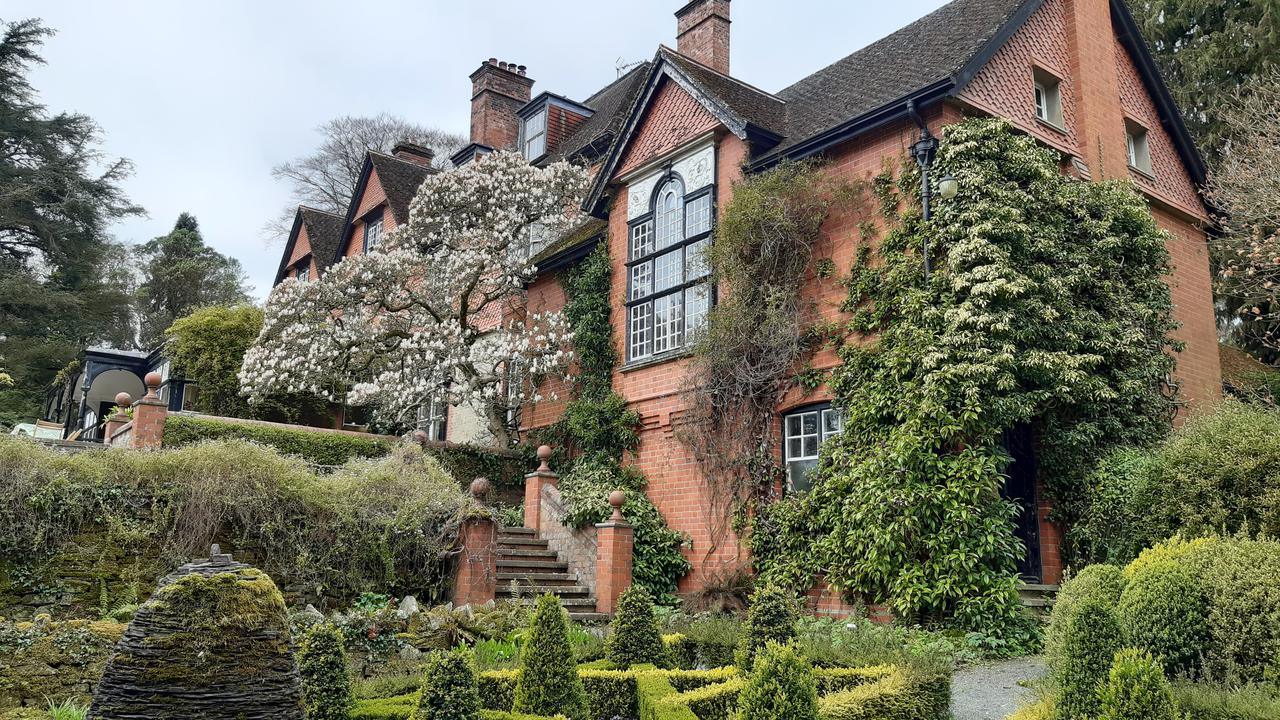
There are over 70 acres of different types of garden at Hergest Croft, and the house had a wonderful cafe full of vegetarian food. Our slow and steady wandering through this place was just the antidote we needed to the plastic pastoral fakery of Hay-on-Wye and the travails of the previous days walking.
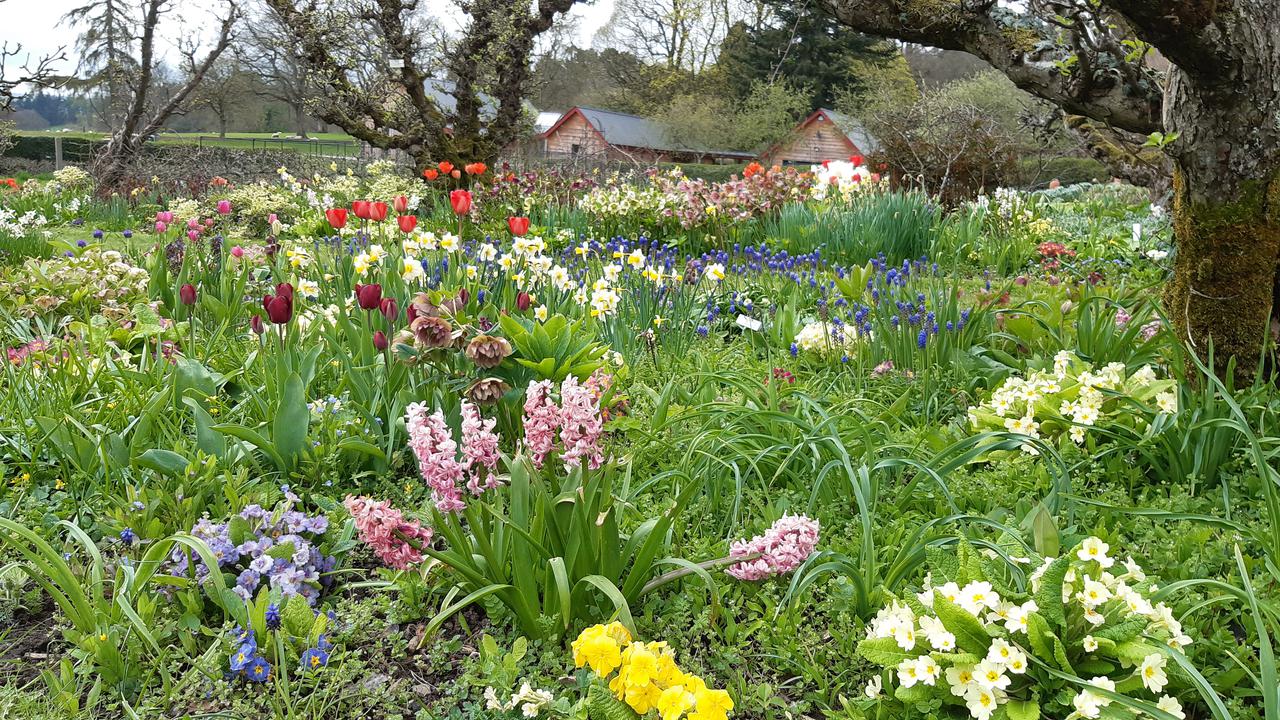
Whilst exploring the rhubarb patch in the kitchen gardens the phone rang again and Mary found a park bench to talk to the friendly nurse tasked with triaging her knee.
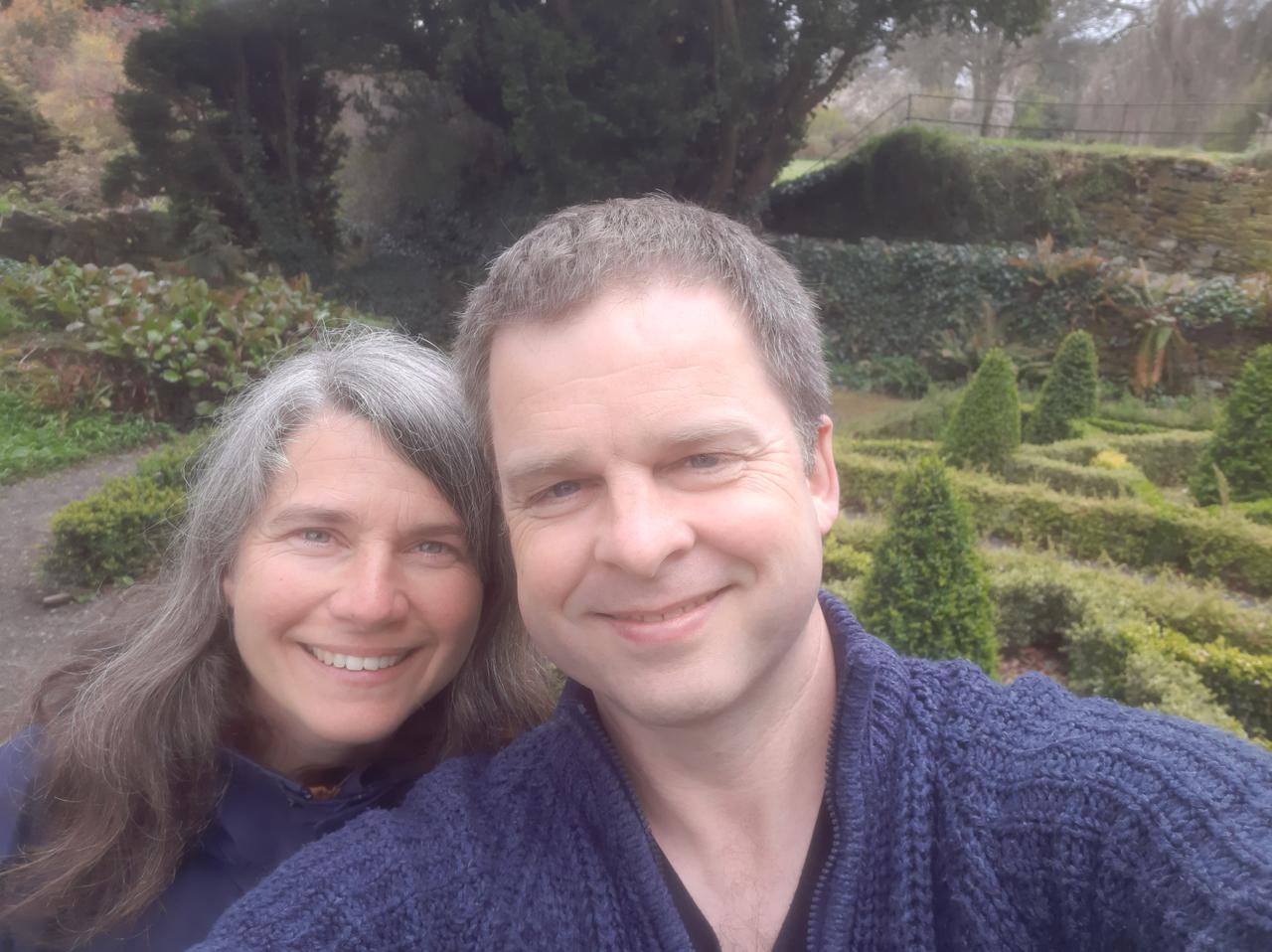
To cut a long story short, I'm currently typing this in the waiting area of Llandrindod Wells hospital's minor injuries unit while Mary is being seen by a physiotherapy nurse. All told, it has taken around three hours from Mary's first contact to her receiving treatment for her knee.
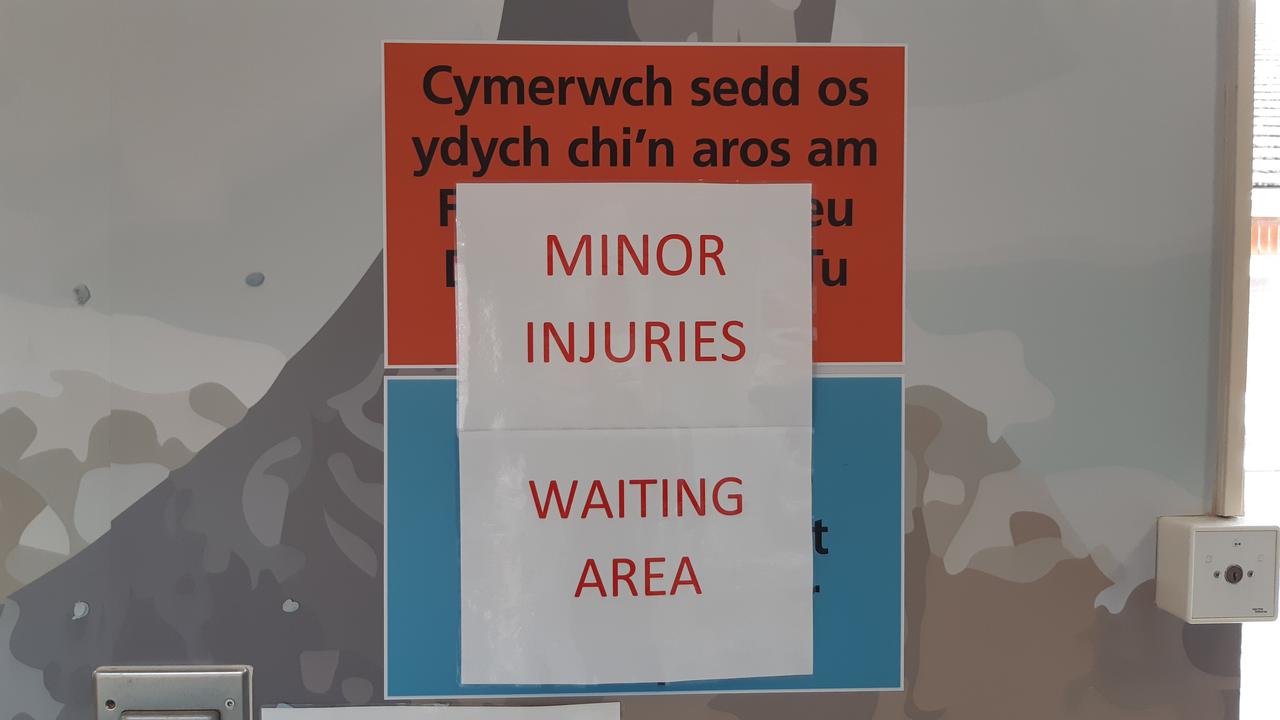
We'll check into this evening's rest-stop and find a good pub for this evening's meal. Tomorrow will be another day of gentle poddling andante con spirito.
Just like real life, our Offa's Dyke journey is turning up all sorts of unforeseen and challenging situations... yet Mary and I continue to support and encourage each other as we improvise and adapt to an unforeseen touring holiday.
My feet are feeling fine today, so perhaps -- assuming the nurse doesn't tell Mary she needs a new knee (highly unlikely) -- we'll even get some more walking in before we've finished.
A few hours later, in our B'n'B for the evening: After a series of tests, it turns out that Mary's knee is not permanently injured, but just over-worked, bruised and thus complaining. The nurse told her she needs to rest it for the next three days or so, while still keeping it moving so it doesn't stiffen up.
After that, I guess we'll be playing it all by ear when it comes to rambling Offa's Dyke (of which we've already walked almost 60 miles in three days).
I get the feeling we're not done yet.
Onwards!